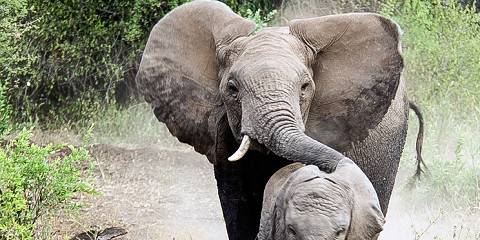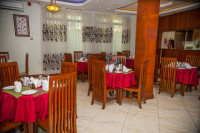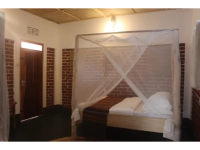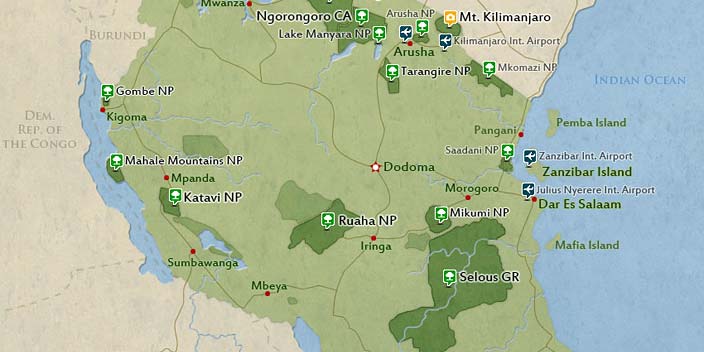
Arrival
Arrival

Day 1
Arrival at Kilimanjaro International Airport
Arrival at Kilimanjaro International Airport
On arrival at Kilimanjaro International Airport (JRO) or Arusha Airport (ARK) which caters for domestic flights, you will be met by a Dancing Simba Safaris representative who will drive you to your accommodation. Your overnight stay will be at the booked accommodation in Arusha, awaiting the beginning of your safari the following day.
- Main Destination:
- Arusha (City)
- Accommodation:
- Graceland Hotel
- Meals & Drinks:

Day 2
Arusha to Lake Manyara National Park
Arusha to Lake Manyara National Park
After an early breakfast, we depart to Lake Manyara National Park. It is an unspoiled paradise and is best known for its abundance of birds and tree-climbing lions. The dramatic western escarpment of the Rift Valley forms the park's western border. To the east is the shallow, alkaline Lake Manyara, which covers a large area of the park. It floods and dries with the seasons, and is home to thousands of flamingos during the rains. The name Manyara comes from the Maasai word "emanyara", a popular plant used to build the protective enclosure around a family homestead. The park's vegetation is diverse, ranging from savannah to evergreen forest. On your exploration of the park, you may see giraffe, zebra, wildebeest, buffalo, elephant, and if you are lucky, lions lounging in the trees.
- Main Destination:
- Lake Manyara National Park
- Accommodation:
- Karatu Safari Camp Lodge
- Meals & Drinks:

Day 3
Lake Manyara to Serengeti National Park
Lake Manyara to Serengeti National Park
After an early breakfast, we depart to Serengeti National Park, a truly spectacular park. It is famous for its vast, open grasslands which allow for excellent sightings of wildlife. The Serengeti is Tanzania’s oldest national park and it is also one of the oldest ecosystems on earth. Its climate and vegetation have remained largely untouched for millions of years. Whilst the Serengeti boasts abundant wildlife, it is perhaps best known for the annual great migration and the presence of the big cats including lions, leopards, and cheetahs, as well as its incredible endless plains. Vast numbers of wildebeest, accompanied by large numbers of zebra and antelope, move in an annual pattern, constantly seeking fresh grazing. The precise timing of the migration is entirely dependent upon the rainfall patterns each year.
- Main Destination:
- Central Serengeti National Park
- Accommodation:
- Budget camping
- Meals & Drinks:

Day 4
Full-day Serengeti National Park
Full-day Serengeti National Park
Today, you will leave the camp with a packed, hot lunch and proceed on a full-day game drive. Look out for the big cats such as lions, leopards and cheetahs, as well as elephants, buffaloes, antelopes, and many others. Experience the beautiful landscapes. If you are visiting during the wildebeest migration, your safari guide will take you to witness this iconic natural event with thousands of zebra, wildebeest, and antelope. You will enjoy your hot lunch in the bush, then proceed with the game drive until sunset. We will return to the camp for dinner and overnight and prepare for the next day.
- Main Destination:
- Central Serengeti National Park
- Accommodation:
- Budget camping
- Meals & Drinks:

Day 5
Serengeti to Ngorongoro Conservation Area
Serengeti to Ngorongoro Conservation Area
Go on an early morning game drive in Serengeti National Park, and return to the camp for brunch. We will then proceed to the Ngorongoro Crater. You will enjoy a game drive and a picnic lunch en route. Later, you will make your way to the Simba camping site for dinner and your overnight stay.
The main feature of the Ngorongoro Conservation Authority is the Ngorongoro Crater, the world's largest inactive, intact, and unfilled volcanic caldera. The crater, which formed when a large volcano exploded and collapsed on itself 2 to 3 million years ago, is 610 meters (2,000 feet) deep, and its floor covers 265 square kilometers.
- Main Destination:
- Serengeti National Park
- Accommodation:
- Budget camping
- Meals & Drinks:

Day 6
Ngorongoro Crater to Tarangire Park
Ngorongoro Crater to Tarangire Park
After an early breakfast, you will descend the crater which is almost 610 meters deep. The crater was created when a large volcano exploded and collapsed on itself 2 to 3 million years ago. It is famous for both its geological delights, and for being a natural reserve that is home to some of the densest large mammal populations in the whole of the African continent. The drive down into the crater is an adventure in itself. When you reach the crater floor, you quickly find yourself amongst large numbers of wildebeest, zebra, gazelle and more than 500 bird species. The crater provides you with the best chance of seeing the endangered black rhino, which can sometimes be spotted in the open grasslands, as well as other members of the Big Five. Later, you will enjoy your hot lunch and drive out of the park to Fig Tree Lodge.
- Main Destination:
- Ngorongoro Crater
- Accommodation:
- Karatu Safari Camp Lodge
- Meals & Drinks:

Day 7
Tarangire to Arusha town/airport
Tarangire to Arusha town/airport
Early morning after breakfast, we depart to Tarangire National Park. The park is named after the Tarangire River which runs throughout the year. This "river of warthogs" is the only source of water for wildlife in the region during the dry season. In places, the vegetation is quite dense. It includes elephant grass, acacia woodlands, and lush groundwater forest. The park is well-known for its elephant families which can often be seen congregating by the river. It is said that more than 3,000 elephants can be found here. You may also see giraffe, bushbuck, and hartebeest. These animals are closely followed by a range of predators, including lions and leopards. There are plenty of breeding bird species found in Tarangire. Later, we will drive back to Arusha town or the airport where we will drop you off.
- Main Destination:
- Tarangire National Park
- Accommodation:
- No accommodation (End of tour)
- Meals & Drinks:


























